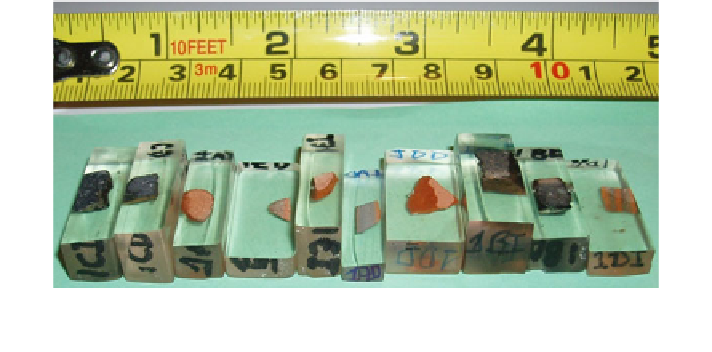Information Technology Reference
In-Depth Information
Fig. 6.5 Bits taken from the ceramic fragments included in the test probes prepared for the
Scanning Electron Microscope
With regard to the methods used to manufacture the ceramics, they were dif-
ferent according to the evolution in time of the processing techniques. The set of
ceramic fragments were from three regions (Requena, Enguera, and Liria) from the
Valencia Community at the East of Spain. The pieces of the Bronze Age were
from Requena (XXX-XX centuries B.C.). They were handmade using basic
appliances, with an appearance very coarse, rudimentary, and of irregular texture
for household. Manufacturing was local and authentic of every town; it was related
to the women's domestic activities. From the dark tone of the Bronze Age
ceramics, it can be inferred that they were made in reducing atmosphere, i.e., in
closed oven at low temperatures. Iberian fragments corresponded to brush-decorated
with geometric, zoomorphic, and human motifs or non-decorated vessels. These
pieces have been dated at about V-III centuries B.C and they were from three
different deposits. Paste of the Iberian ceramics was much more fine and elabo-
rated than the Bronze Age ceramic paste. The technological innovation in the
processing of the pieces was the use of lathe.
The Roman fragments of the three groups (sigillata, common, and amphora)
showed technical perfection of manufacture using different techniques: lathe,
handmade, and mold. They were from I-III centuries. In this period, the applications
of molds for potters allowed mass production of ceramics. Sigillata ceramic fea-
tures a red bright varnish that is obtained applying a clay solution to the ceramic
surface and cooking at high temperatures in open oven (oxidizing atmosphere).
Sigillata pieces were decorated with reliefs of different motifs and were luxury
ceramic. Common and amphora types of Roman ceramic were made using lathe.
They were rough appearance without decoration and for household and/or storage
or transport use. The Middle Ages pieces were of two subperiods: Islamic and
Christian (around VIII-X centuries). The Islamic pieces were from caliphate vessels
of paste simple elaborated without decoration and special treatment. The Christian
pieces were white gross paste of diverse typologies, some without decoration and
some with incisions or decorations in black painted with manganese oxide.

Search WWH ::

Custom Search